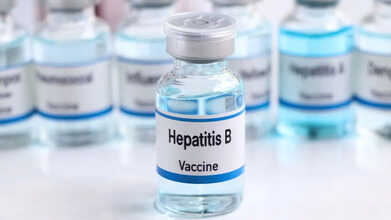- Health Conditions A-Z
- Health & Wellness
- Nutrition
- Fitness
- Health News
- Ayurveda
- Videos
- Medicine A-Z
- Parenting
Women With Autoimmune Diseases Face Greater Risk Of Deadly Heart Complications; How To Protect Yourself?

Autoimmune illnesses like rheumatoid arthritis (RA), lupus, and systemic sclerosis have long been famous for their creation of chronic inflammation and joint devastation, but new evidence is surfacing that these diseases are subtly damaging the heart—particularly among women. The study, reported in Circulation: Cardiovascular Quality and Outcomes, estimated that women who have these disorders are at 50% higher risk of heart disease-related death than men. Although progress has been made in treating autoimmune diseases, the cardiovascular dangers they pose—especially to women—are underdiagnosed and undertreated.
Autoimmune illnesses are much more common in women. Almost twice to three times as many women have RA compared to men, and with lupus, it is nine times as many. Systemic sclerosis, characterized by tightening of the skin and possible damage to internal organs, also occurs more often in women.
The higher cardiovascular death rate in women with these diseases is not just a statistical coincidence. Dr. Heba Wassif, Director of Cardio-Rheumatology at Cleveland Clinic and senior author of the study, highlights that the burden of cardiovascular disease in immune-mediated inflammatory conditions is both substantial and disproportionately impacts women. This prompts important questions about how autoimmune-driven inflammation specifically affects women's cardiovascular health—and why their risks have been so historically underestimated.
In perhaps the most thorough analysis yet, scientists sifted through data on over 281,000 deaths attributed to RA, lupus, and systemic sclerosis between 1999 and 2020. More than 127,000 of those were from heart complications.
While overall mortality rates for heart disease fell—from 3.9 to 2.1 per 100,000 among women and from 1.7 to 1.2 among men—the gap between men and women narrowed only slightly: women continued to die from heart disease at disproportionately higher rates.
Even more alarming, stroke and blocked arteries (atherosclerosis) became the leading killers of women, along with the stark rate of deaths due to irregular heart rhythms and cardiac arrest—over twice that of men.
How Autoimmune Inflammation Damages the Heart?
Autoimmune diseases induce the body to mistakenly attack its own tissues. In RA, the immune system assaults the synovium—the joint lining—leading to swelling, pain, and inflammation. But this inflammation does not end here. It can spread to essential organs, such as the heart, lungs, and blood vessels.
Chronic inflammation promotes the formation of plaque in arteries, damages the linings of blood vessels, and accelerates atherosclerosis—a key risk factor for heart attack and stroke. In addition, the systemic inflammation can provoke arrhythmias and worsen heart failure.
The same medications that treat autoimmune diseases—like corticosteroids and certain immunosuppressants—can also increase cardiovascular risks indirectly by elevating blood pressure, blood sugar, or cholesterol levels if not monitored carefully.
How Heart Diseases have Become a Leading Killer in Autoimmune Patients?
Dr. Issam Motairek, lead author of the study, points to a dramatic change in the perception of mortality among autoimmune patients. "There is a general belief that individuals with immune-mediated inflammatory diseases die mostly from infections or kidney disease," he said. "But our study found that one-third of deaths in this group were caused by cardiovascular disease."
This change points to an urgent necessity to rephrase the way we perceive autoimmune conditions—not only as musculoskeletal or cutaneous problems, but as inflammatory disorders of the whole body with lethal cardiovascular ramifications.
Ways to Control Autoimmune Flares to Keep Your Heart Safe
Most of this cardiovascular danger can be avoided. Here is the way in which women suffering from autoimmune disorders can actively shield their heart:
Early and recurrent cardiovascular screening – At the diagnosis of autoimmune disease, screening should be done by Dr. Wassif and then on a regular basis thereafter. This will include blood pressure, cholesterol, glucose levels, and inflammation markers.
Aggressive inflammation control – Treatment of RA or lupus early and effectively not only benefits the joints but also curtails systemic inflammation that can harm the heart.
Lifestyle interventions – Exercise, a heart-healthy diet, stress reduction, and smoking cessation are even more crucial in this group. Exercise may be difficult during flare-ups, but low-impact exercise such as walking or yoga can be helpful.
Weight control – Achy joints and fatigue can reduce mobility, promoting weight gain. But obesity itself is a principal cause of high blood pressure, diabetes, and heart disease—each of which multiplies the risks for autoimmune patients.
Collaborative working with healthcare providers – Rheumatologists, cardiologists, and primary care physicians must work in concert. An expert cardio-rheumatology team, such as at premier institutions like Cleveland Clinic, can provide individualized care.
Of all autoimmune conditions researched, rheumatoid arthritis carried the greatest risk of cardiovascular mortality. RA not only inflames joints—it can also cause damage to heart valves, inflammation of the heart muscle (myocarditis), and pericarditis (inflammation of the outer layer of the heart). In addition, RA is frequently accompanied by fatigue, low-grade fever, and decreased activity—all of which can conceal or exacerbate heart disease.
This seminal study should be an eye-opener for both patients and clinicians. It reinforces the need not to brush off symptoms such as palpitations, chest pain, shortness of breath, or fatigue in women with autoimmune diseases. It also highlights the imperative of greater gender-specific research and an overarching, preventive approach to autoimmune diseases—not merely for joint well-being, but for survival.
If you’re a woman living with an autoimmune inflammatory disease, protecting your heart isn't optional—it’s essential. Don’t wait for a cardiac symptom to speak up. Be your own advocate, and demand comprehensive cardiovascular care. Early detection, effective inflammation control, and lifestyle support can go a long way in reducing your risk—and adding years to your life.
Depo Provera: New FDA Label Highlights Possible Brain Tumor Risk

Credits: AP
Depo Provera: The Food and Drug Administration approved a label change on Friday for Pfizer’s birth control injection, Depo-Provera, alerting patients to the risk of meningioma, a tumor that develops in the lining of the brain.
Pfizer is currently facing a lawsuit from over 1,000 women who allege that the company knew about the risk but failed to warn users.
How Depo-Provera Works
Depo-Provera is administered as a progestin injection every three months. The lawsuit highlights studies dating back to 1983 linking progesterone with meningioma, claiming that Pfizer had an “unassignable duty to investigate” and should have examined the potential risks of Depo-Provera much earlier. (Progestin is a synthetic form of progesterone.)
According to the Centers for Disease Control and Prevention, roughly one in four sexually active women in the U.S. has used Depo-Provera, with Black women using it at nearly twice the national rate.
Depo Provera: Understanding Meningiomas
Meningiomas are generally non-cancerous, meaning they do not spread to other areas of the body. However, depending on their size and location, they can still be dangerous. In the U.S., about 39,000 meningiomas are diagnosed annually, though the overall risk remains small, as per CDC.
Depo Provera: Pfizer’s Response and FDA Review
Earlier this year, Pfizer requested a judge dismiss the lawsuit, stating that it became aware of the meningioma risks linked to Depo-Provera in 2023. In February 2024, the company applied to the FDA to add a warning to the injection’s label, also requesting warnings for two lower-dose pills containing medroxyprogesterone acetate (MPA), the active ingredient in the shot, as per NBC News.
The FDA denied the request for the pills, explaining that “the findings of the available observational studies alone do not support the addition of a warning on Meningioma risk to medroxyprogesterone acetate (MPA)-containing products.”
Pfizer then amended and resubmitted the application in June 2025. In response, the FDA approved a label change this month for two injection versions — Depo-Provera CI and Depo-Subq Provera 104.
“We acknowledge receipt of your amendment dated June 12, 2025,” the FDA letter to Pfizer said. The approval “provides for the addition of information related to Meningioma risk” on the product label.
Depo Provera: Pfizer’s Statement
A Pfizer spokesperson told NBC News that “the label update reflects a recent decision by the FDA to approve the warning, which the agency had earlier denied.”
“Pfizer stands behind the safety and efficacy of Depo-Provera, which has been used by millions of women worldwide and remains an important treatment option for women seeking to manage their reproductive health,” the statement added.
Lawyers representing the women suing Pfizer said: “For years, Pfizer misled doctors, patients, and the FDA about Depo-Provera’s link to meningiomas, resulting in needless suffering for thousands of women who developed these serious brain tumors. … We applaud the FDA in finally requiring this label change to better inform and protect women.” The FDA did not immediately respond to requests for comment. Elsewhere, warnings about meningioma have already been added to Depo-Provera’s label.
In 2024, the European Medicines Agency listed meningioma as a “possible side effect” for drugs with high doses of MPA. That same year, Canada updated the drug’s label to include meningioma under “warnings and precautions,” noting that meningiomas have been reported following long-term use of progestins, including MPA.
As per NBC News, in January, South Africa’s regulatory agency recommended updating the MPA drug label to include meningioma risk as well. The judge has not yet issued a ruling in the ongoing lawsuit against Pfizer in the United States.
CDC Formally Ends Universal Hepatitis B Vaccination Guidance—What Does It Mean For Newborns?

Credits: Canva
The U.S. Centers for Disease Control and Prevention on Tuesday withdrew its decades-old guidance that all newborns in the country should be vaccinated against hepatitis B at birth. Instead, the decision has now been shifted to parents, who are advised to consult a healthcare provider when deciding whether babies born to hepatitis B-negative mothers should receive the vaccine, including the birth dose.
The change follows a recommendation made by Health Secretary Robert F. Kennedy Jr.’s vaccine advisory panel, marking a significant shift in public health policy. Earlier this month, the panel suggested that the birth dose be limited to newborns whose mothers test positive for hepatitis B or whose infection status is unknown. The CDC approved this recommendation as official policy on Tuesday. Here is what this change means for newborns moving forward:
Also Read: Indoor Air In Delhi Is More Toxic Than Outdoor Smog, Pulmonologist Warns
CDC Ends Guidance That All Newborns Should Get Hepatitis B Vaccine
Under the updated guidance, if parents decide against vaccinating their baby at birth but later believe the shot is necessary, the CDC now advises waiting until the child is at least two months old before administering the first dose. Since 1991, U.S. health authorities have supported universal infant vaccination against hepatitis B, with the first of three doses typically given shortly after birth. CDC recommendations influence health insurance coverage decisions and serve as a key reference point for doctors when determining vaccine schedules.
Public health experts have raised concerns that the shift toward what the CDC calls “individual-based decision-making” may leave more children vulnerable to the virus and could encourage families to skip vaccination without a strong federal directive. Kennedy, who has long opposed vaccines, has already introduced sweeping changes to the country’s vaccination policies.
CDC New Guidance On Hepatitis B Vaccine: What Does This Mean For Newborns?
Rather than advising hepatitis B vaccination for every newborn, the CDC now formally recommends that women who test negative for the virus discuss with their healthcare providers whether their babies should receive the first dose within 24 hours of birth. According to NBC News, the agency is also evaluating another proposal from the advisory panel, which suggests parents consult doctors about testing children for hepatitis B antibodies before deciding on second doses of the vaccine. Typically, the hepatitis B vaccine is administered as a three-dose series during infancy.
Also Read: ‘Fix Your Handwriting’: Indian Doctors Told to Write Clear, Legible Prescriptions Under New Rules
This policy shift stands out as one of the clearest departures from established medical consensus reflected in current CDC guidance. During discussions, the advisory committee relied on selective data and misinformation, while overlooking decades of research showing that hepatitis B vaccines are both safe and highly effective when given soon after birth.
“Removing the recommendation for newborns increases the likelihood that case numbers will rise again. This makes America sicker,” Senator Bill Cassidy, R-La., a liver specialist who has treated hepatitis B patients, wrote on X earlier this month. Despite the change, pediatricians are still expected to encourage parents to vaccinate their newborns.
The Department of Health and Human Services has stated that the updated guidance will not change insurance coverage for the vaccine. The shots will also remain available to newborns through the Vaccines for Children Program, which provides vaccines at no cost to uninsured or underinsured families.
Last month, the CDC also revised a webpage that had previously stated clearly that vaccines do not cause autism. The updated language now says studies have not ruled out a link, despite decades of scientific evidence showing no connection between vaccines and autism.
‘Fix Your Handwriting’: Indian Doctors Told to Write Clear, Legible Prescriptions Under New Rules

Credits: iStock
No more scribbling, notes a BBC report from October 1, 2025, where the Punjab and Haryana court tells doctors to fix their handwriting. Now, the National Medical Commission or NMC has issued nationwide order to the doctors to ensure their prescriptions are written in a clear and legible manner.
While jokes around the notoriously bad handwriting of many doctors that only can be read by pharmacist are common in India, but after the High Court's ruling, this joke is taken seriously. The High Court noted that "legible medical prescription is a fundamental right" as it can make a difference between life and death.
What Are The New NMC Guidelines On Doctor's Handwriting?
Under the new directive, the NMC ordered that doctors must:
- Write prescriptions in clear, legible handwriting, avoiding ambiguity.
- Arbitrary or unclear prescription writing will no longer be acceptable, as it compromises patient safety.
- Subcommittees will be formed in all medical colleges to monitor prescription practices and ensure compliance.
- Medical students will be taught the importance of clear prescription writing, making it a core part of clinical training.
The Background Of NMC Guidelines

The Punjab and Haryana High Court ordered doctors to fix their handwritings while it was looking at a case that involved allegations of rape. While checking a medico-legal report written by a government doctor who examined the woman, the court found it incomprehensible.
Justice Jasgurpreet Singh Puri said, "It shook the conscience of this court as not even a word or a letter was legible".
"At a time when technology and computers are easily accessible, it is shocking that government doctors are still writing prescriptions by hand which cannot be read by anybody except perhaps some chemists," said Justice Puri.
Importance Of Clear Prescriptions
The World Health Organization (WHO) identifies medication errors as a major global patient safety challenge, contributing to avoidable injuries and deaths worldwide. Illegible prescriptions are a well-recognised cause of such errors.
A clear and readable prescription also:
Prevents misinterpretation
Poor handwriting leads to misinterpretation of the intended drug name, dosage, or instructions. Many drugs have names that look or sound alike, making clarity critical.
Ensures the right dosage
Unclear instructions when it comes to dosing result in giving out doses that are ten or one hundred times the correct amount, leading to toxicity or therapeutic failure.
Empowers patient understanding
When the patients are able to clearly read and understand the prescriptions and medication labels, they are more likely to take their medications correctly, reducing the margin for errors.
Reduces healthcare costs
Medication errors resulting from unclear prescriptions lead to increased hospital admissions, prolonged lengths of stay, and additional costs, placing a significant burden on the patient and the healthcare system.
© 2024 Bennett, Coleman & Company Limited

